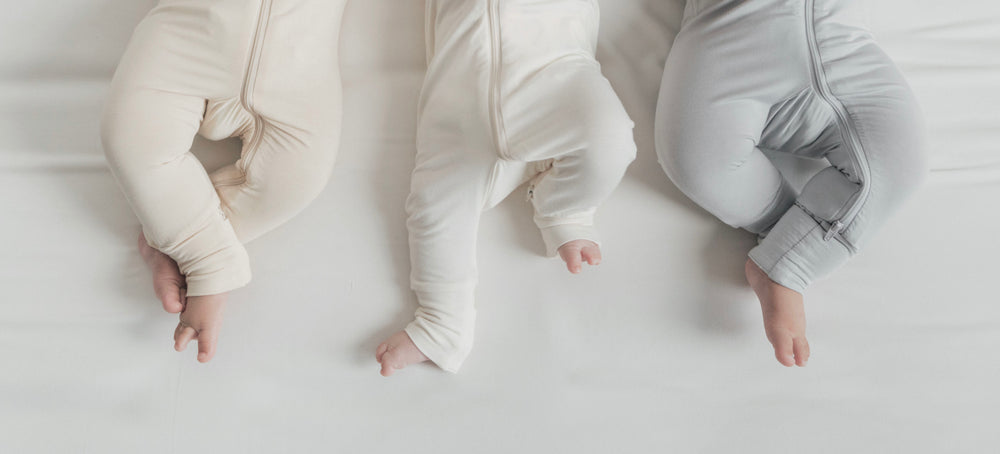Zip Sleepsuits vs Traditional Pyjamas: Which Is Best for Babies?
Deciding between a zip sleepsuit and traditional baby pyjamas can feel surprisingly tricky. Both keep your little one warm, but they do so in very different ways. If you’ve ever wondered which sleepwear style is best for comfort, convenience, and safety, this guide will help you make an informed choice.

1. What Are the Differences?
|
Feature |
Zip Sleepsuit |
Traditional Pyjamas |
|
Fastening |
Zips (often two-way) for quick and easy changes |
Popper or button fastening—can be fiddly and slow |
|
Coverage |
One-piece with arms and legs fully covered |
Often two-piece; may ride up, leaving gaps |
|
Layering Options |
Ideal for layering, especially in colder weather |
Comfortable, but two pieces may create movement gaps |
|
Wear Time |
Suitable for both day and night wear |
Primarily bedtime wear; changes needed at sitting up |
Zip sleepsuits are a practical one-and-done solution that simplify nappy changes and prevent baffling gaps or bunching. Traditional pyjamas can be cosy, but they often require adjustments and additional coverage as babies wriggle and move.
2. Why Zip Sleepsuits Are a Mum Favourite
Safety-first Zips
A two-way zip allows quick access for nappy changes without disturbing your baby—no more fumbling with poppers in the dark.
Comfortable All-In-One Fit
Zip sleepsuits fit like a glove, providing full-body warmth without the risk of a top riding up, which exposed tiny tummies and sent babies into wakeful hiccups.
Added Features
Thoughtful touches like fold-over mitts, footies, zipper guards, and stretchable bamboo fabric (like 95% organic bamboo and 5% spandex) offer comfort, protection, and freedom of movement while supporting healthy hip development.
3. Where Traditional Pyjamas Still Shine
-
Potty Training-Friendly
Two-piece pyjamas make bathroom training easier—just pull down the bottoms, no need to remove a whole suit. -
Individual Washing Convenience
Tops and bottoms can be washed separately, which is handy if only one item needs cleaning. -
Climate Flexibility
In fighting heat waves or tropical climates, a lightweight short-sleeved top and bottom can be more breathable, but only if they stay in place.
4. Safety & Temperature Considerations
Zip Sleepsuits
-
Carefully check TOG ratings to avoid overheating.
-
Stretchy fabrics reduce strangulation risk—you’re less likely to worry about extra layers shifting.
-
Often made of OEKO-TEX® certified bamboo, which is naturally breathable.
Traditional Pyjamas
-
Ensure snug fit to prevent bunching—and frequent checks throughout the night.
-
Natural fabrics like bamboo or pure cotton are preferable to synthetic blends.
5. Which One to Choose?
Here’s a quick guide to decide:
-
Everyday Wear + Sleep? Go for a zip sleepsuit—easy to put on after naps, fuss-free nappy changes, and all-day comfort.
-
During Potty Training? Two-piece pyjamas regain their appeal. Some families even opt for both styles simultaneously—zips by day, pyjamas by night.
-
Staging a Minimal Wardrobe? Zip sleepsuits cover more ground with fewer items. You may only need 3–4 suits instead of several pyjama sets.
6. See the Full Zip Sleepsuit Buying Guide
If you’re new to zip sleepsuits—or want to compare materials, safety features, and sizing—check out our Ultimate Guide to Choosing the Best Zip Sleepsuit for Your Baby for in‑depth advice.
7. Final Thoughts
Both zip sleepsuits and traditional pyjamas have their advantages. Zip sleepsuits win on convenience, coverage, and safety. Traditional pyjamas offer flexibility during potty training or in warmer climates. Ultimately, your choice depends on your family’s routine, climate, and lifestyle.
Discover bamboo zip sleepsuits designed with dual zips, mitts, footies, and OEKO-TEX® safety at These Tiny Things.
Need more tips? Follow us on:
FAQ
Are zip sleepsuits better than traditional pyjamas?
Zip sleepsuits are often considered more convenient and safer for young babies. They provide full-body coverage, reduce the risk of loose clothing bunching up, and make night-time nappy changes easier with two-way zips. However, traditional pyjamas may be better during potty training or warmer months.
What age is best for zip sleepsuits?
Zip sleepsuits are suitable from newborn to toddlerhood. Many parents use them from day one for their ease and comfort. As babies grow more mobile or begin toilet training, some families transition to two-piece pyjamas.
Do zip sleepsuits cause overheating?
Not if you choose the right material and TOG rating. Bamboo zip sleepsuits, like those from These Tiny Things, are breathable and temperature-regulating—ideal for warm climates or air-conditioned rooms.





